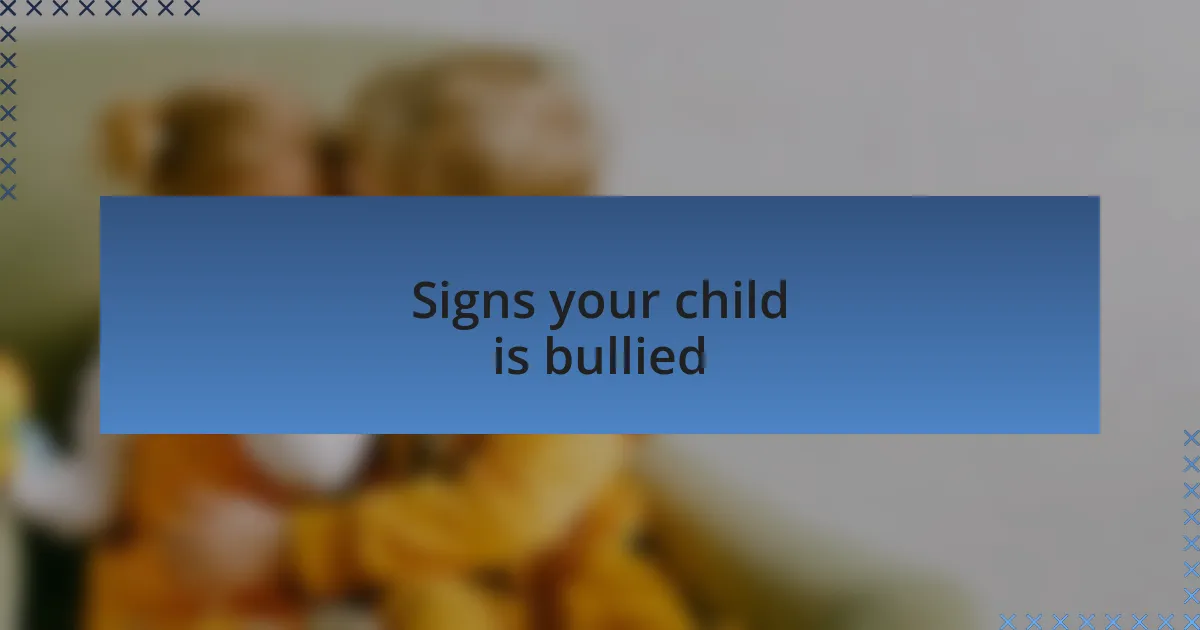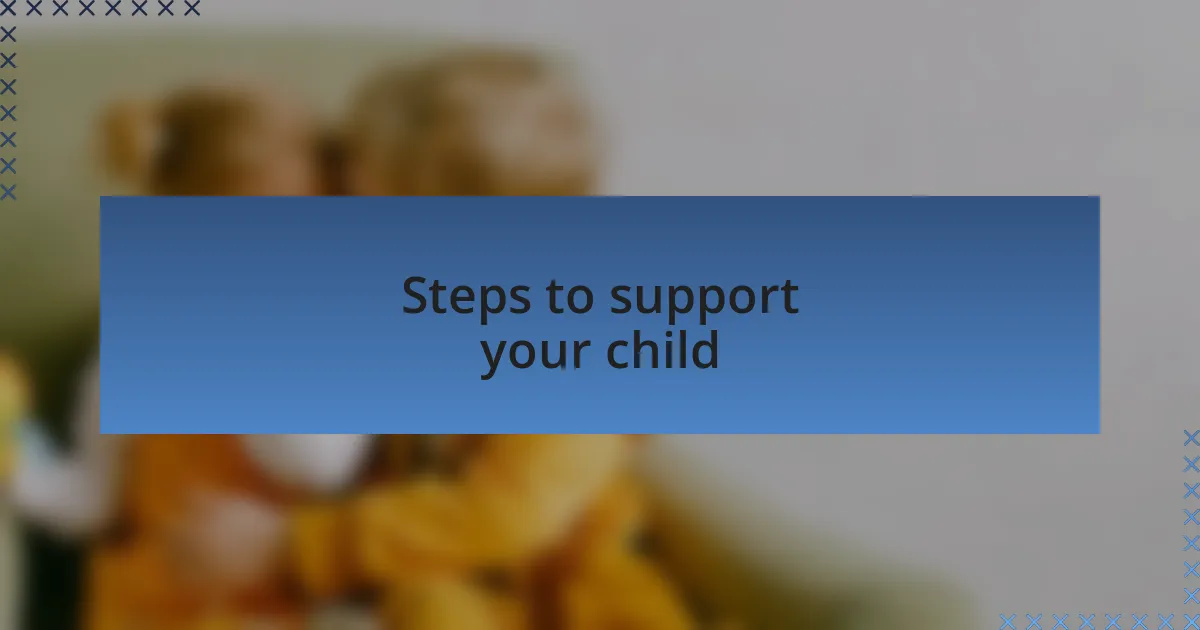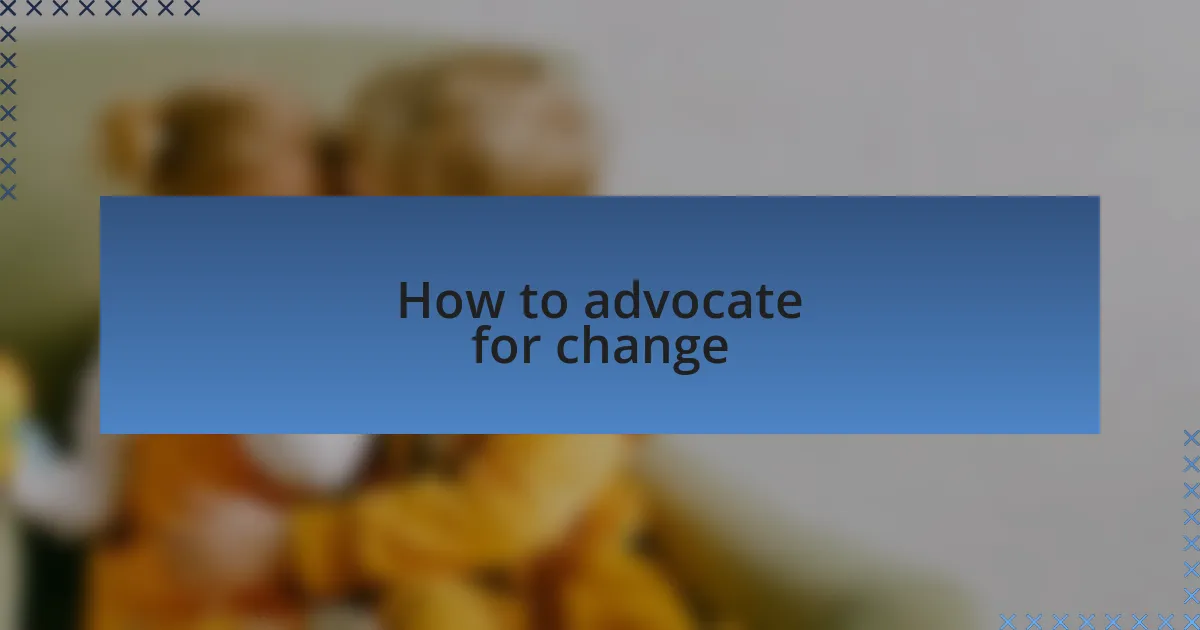Key takeaways:
- Understanding a child’s emotional landscape and maintaining open communication is crucial in addressing bullying.
- Different types of bullying—verbal, physical, and cyberbullying—each require specific awareness and intervention strategies.
- Recognizing signs of bullying, such as changes in behavior or academic performance, can help parents take timely action.
- Advocating for change through community awareness and collaboration with schools can significantly enhance anti-bullying efforts.
Understanding children’s bullying issues
Bullying among children is a complex issue that often emerges from a variety of emotional and social dynamics. I remember when my child first came home visibly upset after a classmate made hurtful remarks. That moment made me realize how deeply even small incidents can affect a child’s self-esteem and overall well-being. It’s not just about the act itself; it’s about the emotions and fears that linger long after.
Each child experiences bullying differently, impacted by factors like their temperament and social skills. I often ask myself, why are some kids more resilient while others crumble under the weight of harsh words? In my experience, understanding a child’s emotional landscape is crucial. I found it helpful to keep the lines of communication open, allowing my child to express not just what happened but how it made them feel. This approach fosters awareness and empathy—a vital foundation for navigating such challenges.
Moreover, the environment plays a significant role in shaping a child’s experience with bullying. I’ve seen how a supportive school community can make a world of difference. When my child felt safe and empowered at school, they were more likely to confront bullies or seek help. It’s vital for parents to engage with teachers and staff, creating a united front against bullying. How can we expect children to cope if we don’t work together to build a culture of respect and understanding?

Importance of addressing bullying
Addressing bullying is essential because it affects not only the targeted child but also the entire school environment. I remember a time when my child was hesitant to attend school, fearing another encounter with their bully. This fear, if left unchecked, can escalate into long-term anxiety or even depression. It’s vital that we, as parents, recognize these signs early and take action to show our children that they are not alone.
Furthermore, tackling bullying fosters resilience—not just in the victims but also in the bystanders. When I witnessed my child standing up for a peer who was being bullied, I felt a surge of pride. It highlighted that when we speak out against intimidation, we empower both the victim and ourselves. Isn’t it inspiring to think that by addressing bullying, we help cultivate a generation that values kindness and courage?
Ultimately, addressing bullying leads to healthier relationships among children and promotes a more compassionate society. I’ve learned that by encouraging open dialogue about feelings and experiences, I allow my child to develop skills not only to handle conflict but also to empathize with others. Isn’t that the kind of emotional intelligence we want to instill in our children?

Different types of bullying
Bullying comes in various forms, each leaving a distinct mark on children. One type that often goes unnoticed is verbal bullying, where hurtful words, insults, or teasing are used to undermine a child’s confidence. I remember talking to my child after they overheard some classmates making fun of their interests. It was painful to see how those seemingly harmless words could linger in their mind and affect their self-esteem.
Then there’s physical bullying, which can be quite alarming for any parent. I once found out that my child was being pushed around during recess. The thought of them being physically hurt was terrifying, and I realized that not only the body but also their spirit was affected. This first-hand knowledge of the lasting impact of physical aggression reminded me of the necessity to have open conversations about safe spaces and reporting issues.
Cyberbullying has also gained prominence, particularly with the rise of social media. My child faced online taunts after posting a picture they were proud of. It made me reflect on how digital interactions can feel relentless and invasive. How do we help our kids handle this new frontier of bullying, where the schoolyard is just a click away? This made me realize the importance of teaching my children about digital citizenship and the impact their words can carry, even across a screen.

Signs your child is bullied
Recognizing the signs that your child is being bullied can be a daunting task. One day, I noticed my child had become unusually withdrawn. They stopped talking about their day and avoided social interactions, which raised a red flag for me. Have you ever seen a sudden change in your child’s behavior that made you worry? It’s crucial to pay attention to these shifts, as they might signal deeper issues.
Another indicator that often goes overlooked is changes in academic performance. I remember feeling alarmed when my child, who had always excelled, suddenly brought home disappointing grades. It was heartbreaking to realize that the stress from bullying could distract them from their studies. Children may feel overwhelmed and unable to focus when they’re dealing with the emotional toll of being bullied, so keeping an eye on their schoolwork can be revealing.
Physical signs can also be a telling aspect of bullying. I distinctly recall a time when my child came home with unexplained bruises. At first, they brushed it off, but I knew something wasn’t right. This experience taught me that we must create an open environment where kids feel comfortable talking about their experiences. Have you ever experienced a moment when you suspected something was wrong but your child hesitated to share? It’s essential to encourage open dialogue and to approach these situations with empathy and understanding.

Steps to support your child
When I first suspected my child was being bullied, my instinct was to create a supportive environment. One step I took was scheduling regular check-ins during our family dinners. This was a time for open conversations where my child could express their feelings without fear of judgment. Do you think having a set time to talk can open up those tough conversations?
Additionally, I encouraged my child to share their experiences with trusted adults, whether it was a teacher or a family member. I remember how it felt to watch my child gain confidence as they found someone who understood their struggles. It’s a reminder that sometimes, a listening ear can make all the difference. Have you thought about the adults in your child’s life who could provide that support?
Finally, I took proactive steps by collaborating with the school to ensure they were aware of the situation. I reached out to my child’s teacher, who was remarkably supportive and made it a priority to foster a safe environment. In my experience, involvement from the school can be crucial, and it made me realize that we are all on the same team when it comes to protecting our children. Have you ever felt empowered by working together with your child’s school?

How to advocate for change
Advocating for change often begins with raising awareness among other parents and community members. I vividly recall joining a local parents’ group where we shared our experiences and strategies. It was inspiring to see how many others were passionate about addressing bullying issues, and together, we brainstormed ways to support each other and our children. Have you ever found strength in numbers?
Another effective approach is to connect with local advocacy organizations that specialize in bullying prevention. I reached out to a charity that focused on promoting awareness in schools and found their resources invaluable. They helped me understand the latest research and offered workshops that empowered parents to speak up, which was a game changer for me. Have you explored similar resources in your area that could amplify your voice?
I also took it upon myself to participate in school board meetings to advocate for stronger anti-bullying policies. Sharing my child’s story and its impact on our family humanized the statistics for the decision-makers in the room. I could feel the shift in the atmosphere as parents and educators began to realize the urgency of creating safer environments. When was the last time you considered how your voice could influence policy changes in your community?

Resources for parents and children
It’s essential for parents to know where to find the right resources to support their children through bullying challenges. For instance, I discovered a fantastic online platform that offered free downloadable guides and toolkits specifically designed for parents. These resources provided practical steps on how to talk to kids about bullying, which not only eased our conversations but also helped my child feel heard and understood. Have you found similar tools that resonate with you and your family?
In addition to online resources, local community centers often host workshops and support groups. I participated in one such group, where I met other parents who were navigating the same struggles. It was uplifting to share our journeys, hear expert advice, and realize that we weren’t alone in this fight. Have you checked what your local community has to offer?
Don’t overlook coaching and mentoring programs for children, either. I enrolled my child in a peer support group that focused on developing resilience and self-esteem, both crucial elements in overcoming bullying. Watching my child flourish in a safe environment, surrounded by understanding peers, reinforced just how impactful these resources can be. What programs have you considered to empower your child?